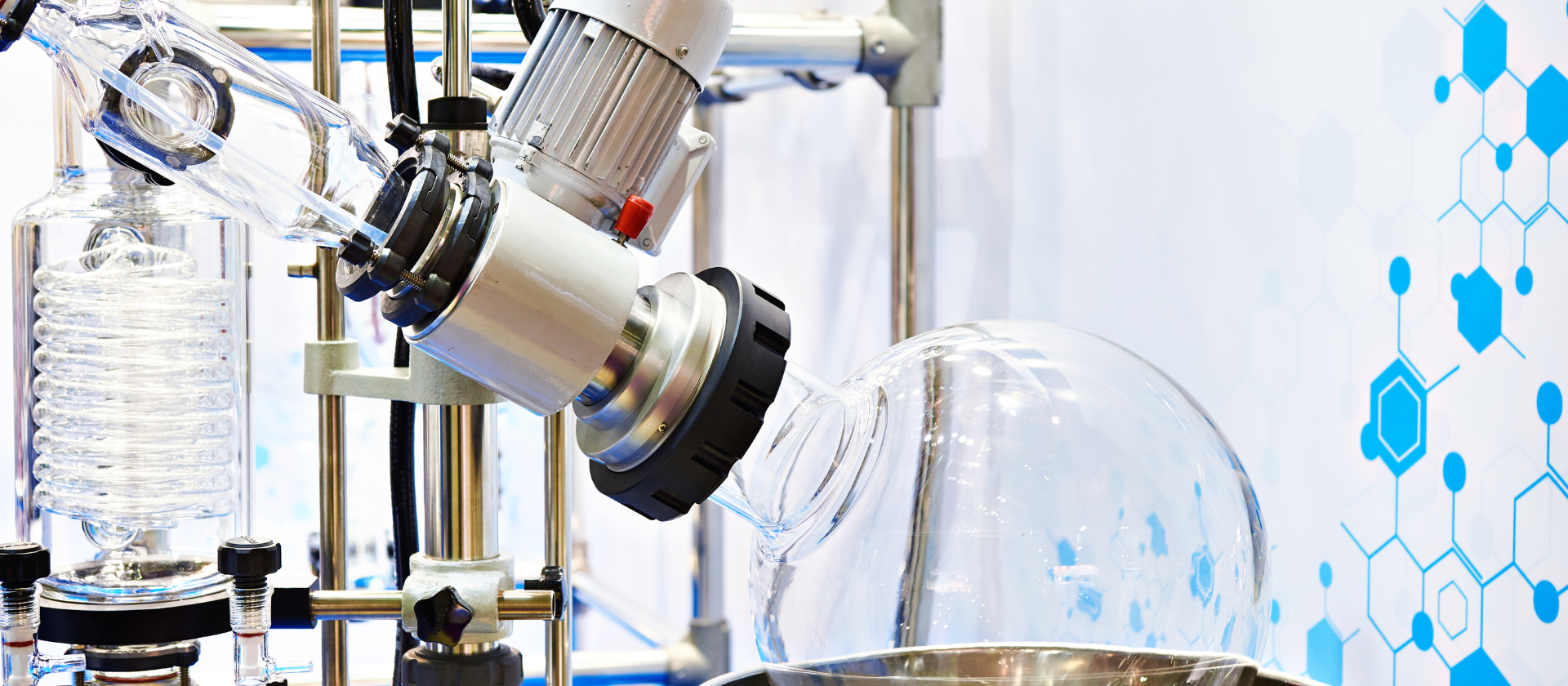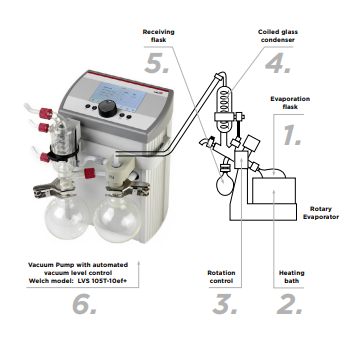Rotary evaporation
is a laboratory technique commonly used for a variety of
applications.
These uses include: removing (distilling or “stripping”) a solvent or solvents from a sample, concentrating a solution, recycling solvents, or synthesizing chemicals.

Common industries include university organic chemistry, biotechnology, pharmaceutical, and food chemistry. The apparatus can range in size from bench scale to pilot scale.
The working principle of a rotary evaporator means that decreasing the pressure above a liquid mixture sample results in the lowering of the boiling points of the mixture’s components. The lowering of the boiling point allows quick, but gentle removal of solvents from a sample. Lowering the boiling point of a liquid mixture is particularly important for heat-sensitive samples.
How it Works
The liquid mixture is placed in an evaporation flask (1) and warmed with heated bath (2), then rotated (3), ensuring that the liquid surface area is increased and evaporation proceeds more rapidly.
As vacuum pressure leads solvents to boil at lower temperatures than when they are exposed to normal atmospheric pressure, evaporating high boiling point solvents is possible without setting the bath to a high temperature that may lead to the sample’s thermal degradation.
Solvent vapors move through a vacuum-tight duct towards a condenser (4) where the vapor is condensed and recovered in a receiving flask (5). Condensers are available in various types depending on the application. Two common types found in bench scale processes are coiled glass condensers and cold finger glass condensers. The cold finger glass condensers use a refrigerant such as dry ice/isopropyl slurry.
A vacuum pump (6) is used to reduce the pressure in the rotary evaporator.
The most
commonly used type of vacuum pump is a chemical duty diaphragm pumps. Chemical
duty diaphragm pumps are used since some solvent vapors pass through the condenser
into the vacuum pump and out its exhaust.
The lowest pressure achievable in a rotary evaporator is typically around 1-2 Torr (1.3 to 2.7 mbar) since there is always some slight
leakage of room air into the rotary evaporator. The leakage is due to leaks at the rotary
seal and other joints in the set-up.
If the vacuum pressure in the rotary evaporator is too low for a given solution, it can lead
to bumping and foaming of the sample. The bumping and foaming is caused by pressure
going well below the boiling point of sample at the set bath temperature. Vacuum
regulation is critical to minimizing this unwelcome effect that will lead to sample loss.
The regulation of vacuum is done manually or is automated.
Keeping the Balance
Success of the entire process is measured by the amount and quality of the desired product obtained through evaporation. Success also resides in the length of time required to complete the procedure. These factors are negatively affected when the evaporation and condensation processes take place too slowly or too quickly and are not balanced against each other. Key factors in finding proper balance include bath temperature, condenser temperature, vacuum level, and rotational speed of the evaporation flask.
While it may be tempting to try to achieve maximum throughput by applying higher temperatures and deeper vacuum to maximize the evaporation rate, such an approach actually introduces a number of serious process risks.
For example, excessive temperature and vacuum levels may damage the compound in process by leading samples to bump and foam, and thus drastically lowering the amount and quality of the end product. They can also translate into a higher solvent loss rate.
When the evaporation rate is higher than the condensation rate, the imbalance creates the need for an oversized pump to handle the excessive solvent vapor and results in a larger portion of the solvent not being recovered. Both of these unwelcome results make the entire process more expensive.
The best way to ensure a well-balanced, controlled rotary evaporation process is to select a high-quality rotary evaporator with a properly sized pump and a vacuum control solution that will help maintain the optimal vacuum level and prevent any process inefficiencies.
The rule of thumb commonly used to set the condenser and bath temperatures in a rotary evaporator is the 20/40/60 rule (also called the 20°C temperature delta rule). For example, the condenser can be set at 20°C, bath temperature set at 60°C, and the vacuum is adjusted so that the solvent vapor temperature is 40°C. For low boiling point liquid mixtures, this rule of thumb will prevent foaming and bumping and will ensure reasonable solvent removal rates.
Due to heat sensitivity of some samples, it can become necessary for bath temperatures to be 40°C or lower. As a result, the rule of thumb may not be followed when using a glass coiled condenser. Low bath temperatures may lead to very slow distillation rates (i.e. milliliters of solvent removed per minute) for high boiling point solvents such as DMF unless the rotary evaporator is run near its lowest achievable vacuum pressure (1-2 Torr or 1.3 to 2.7 mbar).
Automating the Flow to Vary Vacuum Level
Since vacuum pumps are the most critical
components of rotary evaporators, partnering with an experienced vacuum industry manufacturer is the key to ensuring the right equipment for your rotary evaporation procedures.
Welch, a brand of Ingersoll Rand, the world’s leading provider of pressure and vacuum solutions for numerous industries, offers state-of-the-art laboratory vacuum systems (LVS) for solvent evaporation applications that include an oil-free, chemical duty diaphragm pump, a vapor condenser, and optional control and liquid containment features.
The Welch portfolio comprises a wide range of vacuum pumps and systems that are suitable for different flask sizes, vacuum levels, and flow rates, which meet the various needs of all kinds of rotary evaporation processes.







